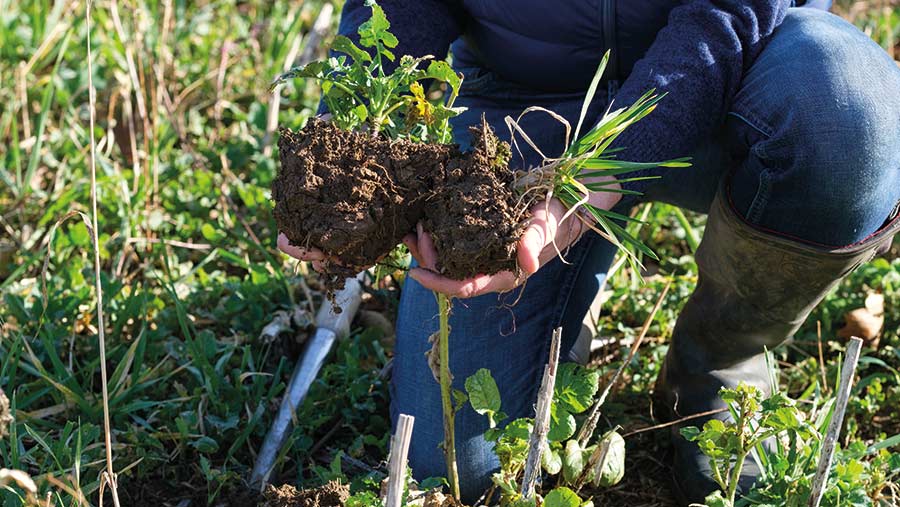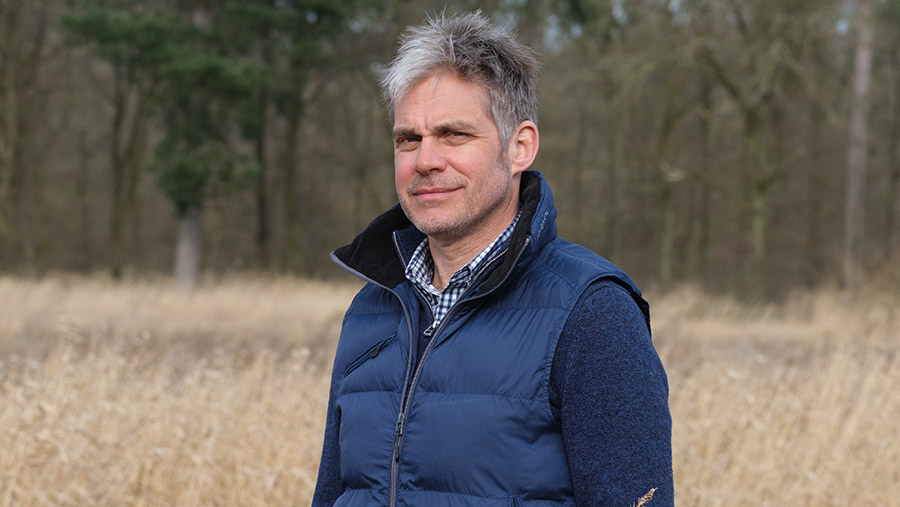How environmental rewards have come from a regen approach
 © Mark Lord Photography
© Mark Lord Photography The environmental impact of every input and field operation is considered before it becomes part of the regenerative system at Whitbread Farms, near Biggleswade in Bedfordshire.
As a result, some of the new Sustainable Farming Incentive (SFI) standards unveiled last month look very interesting at first glance, says farm manager Mike Purnell, who has not committed to the new scheme yet because of existing long-term agri-environment schemes and potential double-funding issues.
See also: Regen ag: Why farmers need to give the system time to deliver
“We haven’t used an insecticide on the farm for years,” he says.
“We also plant a companion crop with our oilseed rape – both of these actions are now part of the new Integrated Pest Management standard, paying £45/ha and £55/ha, respectively, so they look relevant to us.”
However, a 10-year Higher Level Stewardship (HLS) agreement, which has already been extended for a year, is coming to an end in 2023.
A different approach is being contemplated, as the team decides what should be done next and how the farm can deliver more for the environment and wider society.
“It’s potentially a big, bold project with long timelines that brings in other parts of the estate,” Mr Purnell says.
“So we need more detail on the other tiers of Environmental Land Management and clarity on funding, to make sure that we’re doing the most we can for public goods, before committing either way.”

Mike Purnell © Mark Lord Photography
Regenerative rewards
Rewards for using no-till and direct drilling are also being explored in the SFI, he notes. “That’s also relevant to us.
“It’s clear that the regenerative farming techniques that have been used on this farm for the last four years have done more for biodiversity than the existing HLS scheme has.”
As well as reducing input use across the 1,000ha of crops, every field at Whitbread Farms has a 6m margin around it, a diverse seven-year rotation which includes spring crops is in place, multispecies cover crops are grown, and livestock have been integrated.
Chopped straw and organic manures are used to improve soil health, raise organic matter levels and maintain the carbon:nitrogen ratio required for soil biology to function well.
No cultivations have taken place for some time. The farm has also eliminated the use of chemical seed treatments and early prophylactic sprays, reduced its reliance on artificial nitrogen and desiccants, refined variety choice to exploit genetic resistance, and made good use of disease detection techniques.
While the latter have a cost, the use of the SwiftDetect rapid test saved about £2,000 on fungicide costs last year, as well as reducing risk, Mr Purnell reports.
Making it pay
His plan is to produce the same yields at a lower cost. Having improved the soils, he does not accept that there is a yield penalty in a regenerative system and aims for 9t/ha of milling wheat.
Wherever possible, integrated management strategies are used for grassweed control and trials are carried out to look for ways to make further improvements.
“We’re on the right path and will continue to push ahead, but we haven’t been able to monetise regenerative farming yet,” notes Mr Purnell. “Perhaps that’s about to change.”
As all the models indicate that the farm is already carbon-negative, the business has taken the plunge and signed up with Ecometric to measure and sell the carbon that has already been sequestered.
This involves the use of both satellite imagery and soil sampling, so he accepts that there have been higher up-front costs than some of the alternatives.
“We can pull out at any time. Our heavy land is in the scheme, as well as some areas of lighter land, ancient woodland and permanent pasture, to see what the numbers are before committing more land.
“We will be selling measured rather than modelled carbon, which we believe is more credible.”
Cost savings
As well as looking at alternative revenue streams, surviving beyond the Basic Payment Scheme means that all costs are under scrutiny.
Cover crops containing 12 different species come in at a modest £20/ha cost, as the farm grows most of its own seed for these.
Otherwise, home-saved seed is used as far as possible, with all autumn-drilled crops having the endophyte-based dressing Tiros applied, while just one application of buffered glyphosate is made a year onto stale seed-beds.
The cover crops are grazed by sheep, which come onto the farm for a couple of months.
Their success depends on them not disturbing the roots, which are fundamental to soil health and function and play an important role in the regenerative system.
Cattle were used on cover crops as an experiment this year, but Mr Purnell reports: “They’re too heavy so they left the ground uneven – that creates difficulties when it comes to direct drilling the next crop.”
Nitrogen fertiliser
As previously reported in Farmers Weekly, Mr Purnell has been looking for ways to cut his use of nitrogen fertiliser for a few years and has steadily reduced the amount applied.
Last year, he used a total of 210kg/ha of N on the milling wheats, having applied two thirds of this at the end of February with an inhibitor and the remainder at boot splitting.
He also conducted trials using no nitrogen, and a comparison of foliar nitrogen products.
Where no nitrogen was applied to wheat, the crop produced 6t/ha. “It gave a reasonable yield but the grain protein was a disaster, at just 7%,” he recalls.
Three different foliar nitrogen products were tested in the other trial – Nufol, Persist N and an additive for urea/ammonium nitrate liquid fertiliser that is still in development.
The crop received 80kg/ha of N at the end of February and then three applications of 10kg/ha each during the growing season.
“There was no difference between them other than price – in yield, quality or crop safety,” he says.
“The yield was 0.5t/ha lower than the farm standard approach and the protein was 2% down, from a total application of 110kg.”
However, it cost £200/ha less in fertiliser, Mr Purnell points out. “We were financially better off from less yield, but the protein was the problem with our milling wheats.”
Another issue was sulphur (S), as the foliar products contain less of the nutrient, which has a role in nitrogen use efficiency.
“We were probably 40-50kg of S/ha down compared to the rest of the farm, in a very dry year.”
As a result, his plan for this growing season is to put on 100kg/ha at the end of February and then make three applications of 15kg/ha of a foliar product at key growth stages.
Sulphur will also be applied, in the form of polysulphate, in late February.
Oilseed rape returns
After a seven-year break from growing oilseed rape, it came back into the rotation three years ago.
“We’ve de-risked the rape-growing operation,” Mike Purnell explains. “We grow conventional varieties and use home-saved seed, so the costs are low.”
Berseem clover and buckwheat are used as a companion crop, for their soil health, nutrient cycling and diversity benefits, plus any effect they may have on cabbage stem flea beetle.
“One is a nitrogen fixer, the other is a phosphate cycler,” he says. “They cost very little, partly because we grow our own buckwheat seed.”
No desiccants were used last year, with the crop ripening evenly in the hot, dry summer.
“We try not to use glyphosate pre-harvest on any crop – being this far south it’s a sign that our agronomy has failed.”
After some problems with mealy aphid in 2022 he will be using more tissue and sap sampling this year, to try to avoid crops getting stressed.
“We know that pests are more likely to attack a stressed crop, so that will be part of the plan this year.”
He also intends to extend his nitrogen approach to the oilseed rape crop – putting on 80kg/ha of N in early spring, along with sulphur, and then using 20kg/ha of foliar N at the green bud stage.
